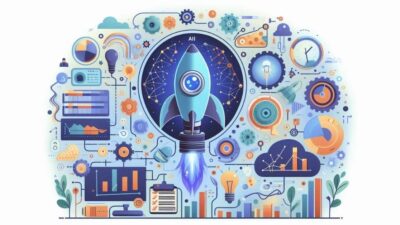
Predicting future sales has always been a challenge for sales leaders. From gut-feel forecasting to spreadsheet guesswork, the traditional approaches are often riddled with bias, inconsistency, and missed targets. But thanks to Artificial Intelligence (AI), building a predictive sales model is no longer a vague aspiration—it’s a strategic advantage. By leveraging AI and machine learning, organizations can now anticipate outcomes, optimize sales pipelines, and forecast revenue with unprecedented accuracy. The question isn’t whether to use AI in your sales model—it’s how quickly you can start.
What is a Predictive Sales Model?
A predictive sales model is a data-driven framework that uses historical data, behavioral patterns, and machine learning to forecast future sales outcomes. Rather than relying on static metrics or subjective inputs, AI-based models dynamically learn from new data and continuously improve over time. These models can predict:
- Which leads are most likely to convert
- How much revenue will be generated this quarter
- Which deals are at risk of stalling
- How long a sales cycle might last
- The ideal touchpoints to move a lead forward
When built properly, predictive models empower sales teams to make smarter decisions—based not on instinct, but on intelligence.
Why AI is a Game-Changer for Sales Prediction
Traditional forecasting tools often fail to consider the complexity of modern sales environments. But AI in sales forecasting changes the game. Here’s why:
- Pattern Recognition: AI identifies trends and correlations in large datasets that humans might miss.
- Real-Time Learning: Machine learning algorithms adapt to new data, refining predictions automatically.
- Scalability: AI models can analyze millions of data points across industries, geographies, and segments without breaking a sweat.
- Actionable Insights: Instead of just numbers, AI offers recommendations—helping sales leaders focus on what matters most.
Building an AI-Powered Predictive Sales Model: Step by Step
Let’s break down how companies can practically build a predictive model using AI:
Step 1: Aggregate Historical Sales Data
The foundation of any predictive model is data. Pull together historical data such as:
- Closed/won and closed/lost deals
- Lead source and engagement history
- Sales rep activity
- Email open and reply rates
- Deal velocity and sales cycle length
- Revenue attribution
This raw data becomes the training ground for your machine learning algorithms.
Step 2: Enrich the Dataset with Behavioral & External Signals
To take your model to the next level, include intent data, firmographics, technographics, and buyer behavior. AI tools can automatically ingest:
- Website activity
- Content downloads
- Buying signals from third-party platforms
- Competitor interactions
- CRM and email engagement metrics
The more context your model has, the more accurate it becomes.
Step 3: Use Machine Learning for Sales Predictions
With the data in place, it’s time to let machine learning for sales do its job. Common models include:
- Classification models: Predict whether a lead will convert.
- Regression models: Forecast potential deal value or revenue.
- Clustering models: Group similar prospects for targeted outreach.
- Time series models: Predict when a deal is likely to close.
AI learns from the outcomes of past deals to project the future—helping you anticipate pipeline health, win probability, and performance risk.
Step 4: Integrate Predictive Insights into Your CRM
Once the predictive model is trained and tested, integrate it into your predictive CRM or sales stack. This makes insights easily accessible to reps and managers in real time. Reps can get alerts like:
- “This lead has a 72% chance of converting—engage now.”
- “Deal X is at risk due to inactivity—take action.”
- “Client Y’s behavior aligns with our top buyers—prioritize follow-up.”
When AI-driven insights are embedded into daily workflows, reps become more focused, efficient, and strategic.
Step 5: Measure, Iterate, and Optimize
Predictive models aren’t set-and-forget systems. Continuously track performance metrics like:
- Accuracy of revenue forecasts
- Lead-to-close ratio improvements
- Sales cycle reductions
- Pipeline velocity changes
As the model learns and improves, your sales strategy becomes sharper and more responsive to real-world dynamics.
The Role of AI-Powered Sales Tools
Several platforms are helping businesses leverage AI-powered sales tools to build and deploy predictive models quickly:
- Salesforce Einstein – Embeds AI in CRM for lead scoring and forecasting
- Salesix.ai – Provides AI voice agents and sales enablement tools that feed real-time data into predictive models
- Clari – Tracks pipeline, forecasts revenue, and offers predictive deal insights
- Gong.io – Analyzes sales calls for sentiment, objections, and deal health indicators
- HubSpot with AI add-ons – Automates lead scoring and predictive segmentation
These tools not only simplify data analysis but also provide sales teams with actionable insights directly within their workflows.
Real-World Impact: Predictive AI in Action
Let’s say you’re in B2B SaaS with a complex sales cycle. Using an AI-powered model, your system identifies that leads from fintech firms who engage with a specific case study and respond within 24 hours to follow-ups are 5x more likely to convert. Armed with this insight, your AI SDRs can:
- Prioritize those leads
- Personalize outreach based on interest
- Set expectations for deal value and timeline
- Hand off to AEs at the optimal time
Suddenly, your sales strategy isn’t based on guesswork—it’s based on data-backed foresight.
Future of Sales: From Reactive to Predictive
Predictive analytics in sales is just the beginning. The future belongs to proactive systems that not only predict but also automate decisions and actions. Combined with AI voice agents, conversational AI, and real-time engagement tracking, the sales stack of tomorrow will operate with minimal manual intervention and maximum precision.
Conclusion
In today’s hyper-competitive markets, intuition is no longer enough. Sales teams need foresight, focus, and agility—and that’s exactly what a predictive sales model powered by AI delivers. From smarter targeting to better forecasting, AI transforms scattered data into actionable strategy. If you’re ready to stop guessing and start growing, there’s no better time to start building your AI-driven predictive sales engine.




